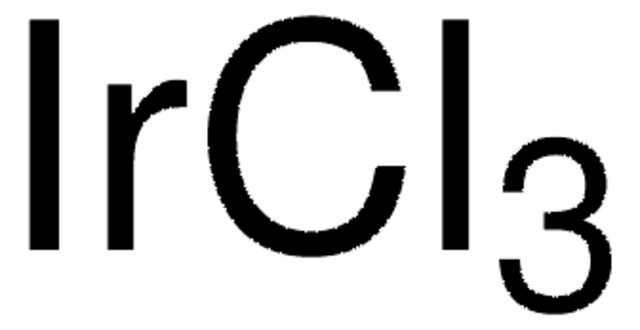449229
Iridium
evaporation slug, diam. × L 0.6 cm × 1.2 cm, 99.9% trace metals basis
Synonym(s):
Iridium black
About This Item
Recommended Products
Assay
99.9% trace metals basis
form
evaporation slug
resistivity
4.71 μΩ-cm
diam. × L
0.6 cm × 1.2 cm
weight
~7.6 g (one slug)
bp
4130 °C (lit.)
mp
2450 °C (lit.)
density
22.65 g/cm3 (lit.)
SMILES string
[Ir]
InChI
1S/Ir
InChI key
GKOZUEZYRPOHIO-UHFFFAOYSA-N
Looking for similar products? Visit Product Comparison Guide
Related Categories
Application
- Single Atom Iridium Decorated Nickel Alloys Supported on Segregated MoO(2) for Alkaline Water Electrolysis.: The study presents an innovative approach to enhance alkaline water electrolysis using single-atom iridium catalysts, resulting in improved efficiency and stability of the process (Wang et al., 2024).
- An Aqueous Redox Flow Battery Using CO(2) as an Active Material with a Homogeneous Ir Catalyst.: This paper explores the use of iridium catalysts in an aqueous redox flow battery, utilizing CO2 as an active material to improve energy storage capabilities (Kanega et al., 2023).
- Kinetic Acceleration of Lithium Polysulfide Conversion via a Copper-Iridium Alloying Catalytic Strategy in Li-S Batteries.: This research highlights the use of copper-iridium alloys to accelerate the conversion of lithium polysulfides, significantly enhancing the performance of lithium-sulfur batteries (Zhai et al., 2022).
- Introducing High-Valence Iridium Single Atoms into Bimetal Phosphides toward High-Efficiency Oxygen Evolution and Overall Water Splitting.: The study demonstrates the integration of high-valence iridium single atoms into bimetal phosphides, leading to highly efficient oxygen evolution and water splitting processes (Yang et al., 2023).
Storage Class Code
13 - Non Combustible Solids
WGK
nwg
Flash Point(F)
Not applicable
Flash Point(C)
Not applicable
Certificates of Analysis (COA)
Search for Certificates of Analysis (COA) by entering the products Lot/Batch Number. Lot and Batch Numbers can be found on a product’s label following the words ‘Lot’ or ‘Batch’.
Already Own This Product?
Find documentation for the products that you have recently purchased in the Document Library.
Articles
Can there be an effective strategy for finding breakthrough materials, since they are, by definition, unpredictable? One answer is found in Combinatorial Materials Science techniques, which represent a powerful approach to identifying new and unexpected materials.
Our team of scientists has experience in all areas of research including Life Science, Material Science, Chemical Synthesis, Chromatography, Analytical and many others.
Contact Technical Service

